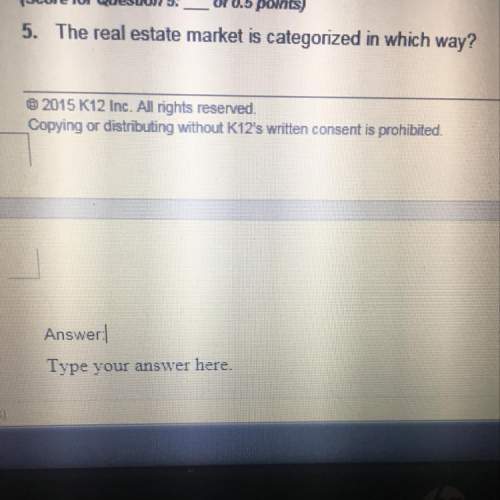
Business, 01.10.2019 19:00 Vanesssajohn2962
Barefoot running company's work in process inventory on june 1 has a balance of $ 22 comma 800$22,800 representing job no. 265. during june, $ 50 comma 000$50,000 of direct materials were requisitioned for job no. 265 and $ 35 comma 000$35,000 of direct labor cost was incurred on job no. 265. manufacturing overhead is allocated at 115115% of direct labor cost. actual manufacturing overhead costs incurred in june amounted to $ 41 comma 400$41,400. no new jobs were started during june. job no. 265 is completed on june 28. what is the total cost assigned to job no. 265?

Answers: 2
Another question on Business

Business, 22.06.2019 13:10
bradford, inc., expects to sell 9,000 ceramic vases for $21 each. direct materials costs are $3, direct manufacturing labor is $12, and manufacturing overhead is $3 per vase. the following inventory levels apply to 2019: beginning inventory ending inventory direct materials 3,000 units 3,000 units work-in-process inventory 0 units 0 units finished goods inventory 300 units 500 units what are the 2019 budgeted production costs for direct materials, direct manufacturing labor, and manufacturing overhead, respectively?
Answers: 2

Business, 23.06.2019 01:00
Need with an adjusting journal entrycmc records depreciation and amortization expense annually. they do not use an accumulated amortization account. (i.e. amortization expense is recorded with a debit to amort. exp and a credit to the patent.) annual depreciation rates are 7% for buildings/equipment/furniture, no salvage. (round to the nearest whole dollar.) annual amortization rates are 10% of original cost, straight-line method, no salvage. cmc owns two patents: patent #fj101 and patent #cq510. patent #cq510 was acquired on october 1, 2016. patent #fj101 was acquired on april 1, 2018 for $119,000. the last time depreciation & amortization were recorded was december 31, 2017.before adjustment: land: 348791equpment and furniture: 332989building: 876418patents 217000
Answers: 3

Business, 23.06.2019 03:00
In each of the cases below, assume division x has a product that can be sold either to outside customers or to division y of the same company for use in its production process. the managers of the divisions are evaluated based on their divisional profits. case a b division x: capacity in units 200,000 200,000 number of units being sold to outside customers 200,000 160,000 selling price per unit to outside customers $ 90 $ 75 variable costs per unit $ 70 $ 60 fixed costs per unit (based on capacity) $ 13 $ 8 division y: number of units needed for production 40,000 40,000 purchase price per unit now being paid to an outside supplier $ 86 $ 74 required: 1. refer to the data in case a above. assume in this case that $3 per unit in variable selling costs can be avoided on intracompany sales. a. what is the lowest acceptable transfer price from the perspective of the selling division? b. what is the highest acceptable transfer price from the perspective of the buying division? c. what is the range of acceptable transfer prices (if any) between the two divisions? if the managers are free to negotiate and make decisions on their own, will a transfer probably take place?
Answers: 3

You know the right answer?
Barefoot running company's work in process inventory on june 1 has a balance of $ 22 comma 800$22,80...
Questions

Mathematics, 22.05.2021 04:50

Mathematics, 22.05.2021 04:50

Business, 22.05.2021 05:00


English, 22.05.2021 05:00

Mathematics, 22.05.2021 05:00

SAT, 22.05.2021 05:00

Social Studies, 22.05.2021 05:00



Mathematics, 22.05.2021 05:00




Mathematics, 22.05.2021 05:00


English, 22.05.2021 05:00



Mathematics, 22.05.2021 05:00




